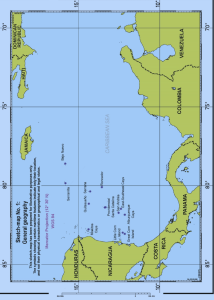Decision and judgement of The INTERNATIONAL COURT OF JUSTICE on Continental Shelf & Exclusive Economic Zones in South America
QUESTION OF THE DELIMITATION OF THE CONTINENTAL SHELF BETWEEN NICARAGUA AND COLOMBIA BEYOND 200 NAUTICAL MILES FROM THE NICARAGUAN COAST
First question formulated by the International Court of Justice (ICJ) was ;
Whether a State’s entitlement to a continental shelf beyond 200 nautical miles from its baselines may extend within 200 nautical miles from the baselines of another State – Determination of the existence of overlapping entitlements as a first step in any maritime delimitation – Preliminary character of the first question – Must be answered to ascertain whether the Court may proceed to the delimitation requested by Nicaragua. Customary international law applicable to the maritime areas at issue – Nicaragua is a party to the United Nations Convention on the Law of the Sea (“UNCLOS”), Colombia is not – Drawing up of UNCLOS at the Third United Nations Conference on the Law of the Sea (the “Conference”) – Relationship between Part V of UNCLOS on the exclusive economic zone and Part VI on the continental shelf specified in Article 56, paragraph 3, of UNCLOS , Articles 56, 58, 61, 62 and 73 of UNCLOS on rights and duties of coastal States and other States in the exclusive economic zone reflect customary international law -There cannot be an exclusive economic zone without a corresponding continental shelf , – Question of “grey area” – Incidental result of adjustment of equidistance line

Source ; ICJ judgement dt 23rd July,2023
Contention of Parties
Exclusive Economic Zones
Nicaragua contends that the continental shelf of these islands should not extend east of the 200-nautical-mile limit of Nicaragua’s exclusive economic zone, due to their small size and their already “much more than adequate” maritime areas resulting from the 2012 Judgment.
For its part Colombia considers that the maritime entitlements of San Andrés and Providencia project in all directions from their baselines and that they therefore extend to the east of the line lying 200 nautical miles from the Nicaraguan baselines. Colombia adds that Nicaragua’s claim contradicts the 2012 Judgment in so far as it would result in the islands being cut off from their maritime entitlements to the east.
Conclusion by ICJ
The ICJ rejected the request made by the Republic of Nicaragua that the Court adjudge and declare that the islands of San Andrés and Providencia are entitled to a continental shelf up to a line consisting of 200-nautical-mile arcs from the baselines from which the breadth of the territorial sea of Nicaragua is measured connecting the points A, C and B co-ordinates of which are already referred to in this judgement.
Maritime Entitlements
The Court notes that the maritime entitlements of San Andrés and Providencia extend to the east beyond 200 nautical miles from Nicaragua’s baselines and therefore into the area within which Nicaragua claims an extended continental shelf. The Court has concluded however that, under customary international law, a State’s entitlement to a continental shelf beyond 200 nautical miles from the baselines from which the breadth of its territorial sea is measured may not extend within 200 nautical miles from the baselines of another State .
Nicaragua is not entitled to an extended continental shelf within 200 nautical miles from the baselines of Colombia’s mainland coast. Accordingly, within 200 nautical miles from the baselines of Colombia’s mainland coast, there is no area of overlapping entitlement to be delimited in the present case.
Nicaragua is not entitled to an extended continental shelf within 200 nautical miles from the baselines of San Andrés and Providencia. Accordingly, within 200 nautical miles from the baselines of San Andrés and Providencia, there is no area of overlapping entitlement to be delimited in the present case.
By Nadir Mumtaz
Source / Credit ;
https://www.icj-cij.org/sites/default/files/case-related/154/154-20230713-jud-01-00-en.pdf

Leave A Comment